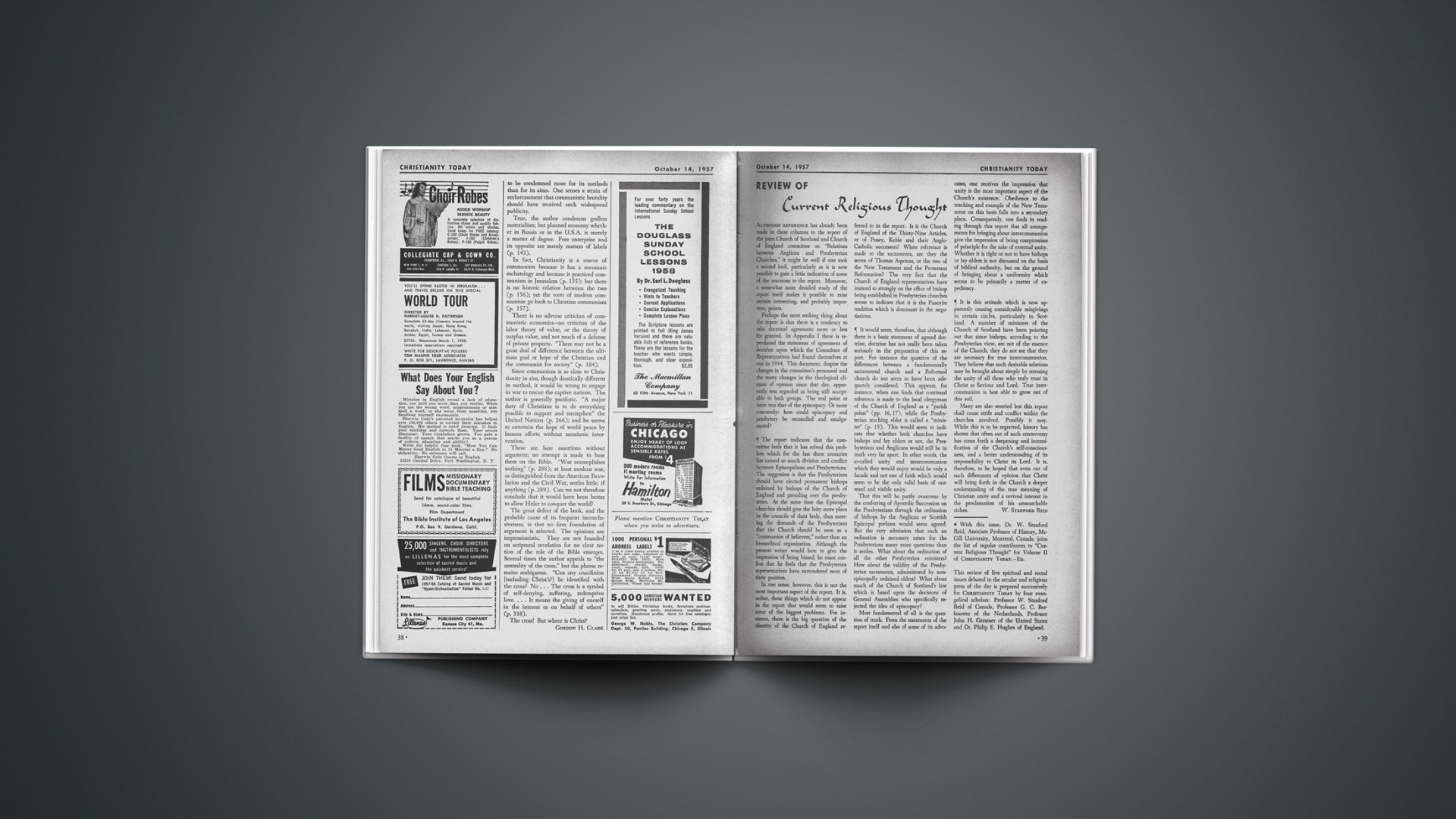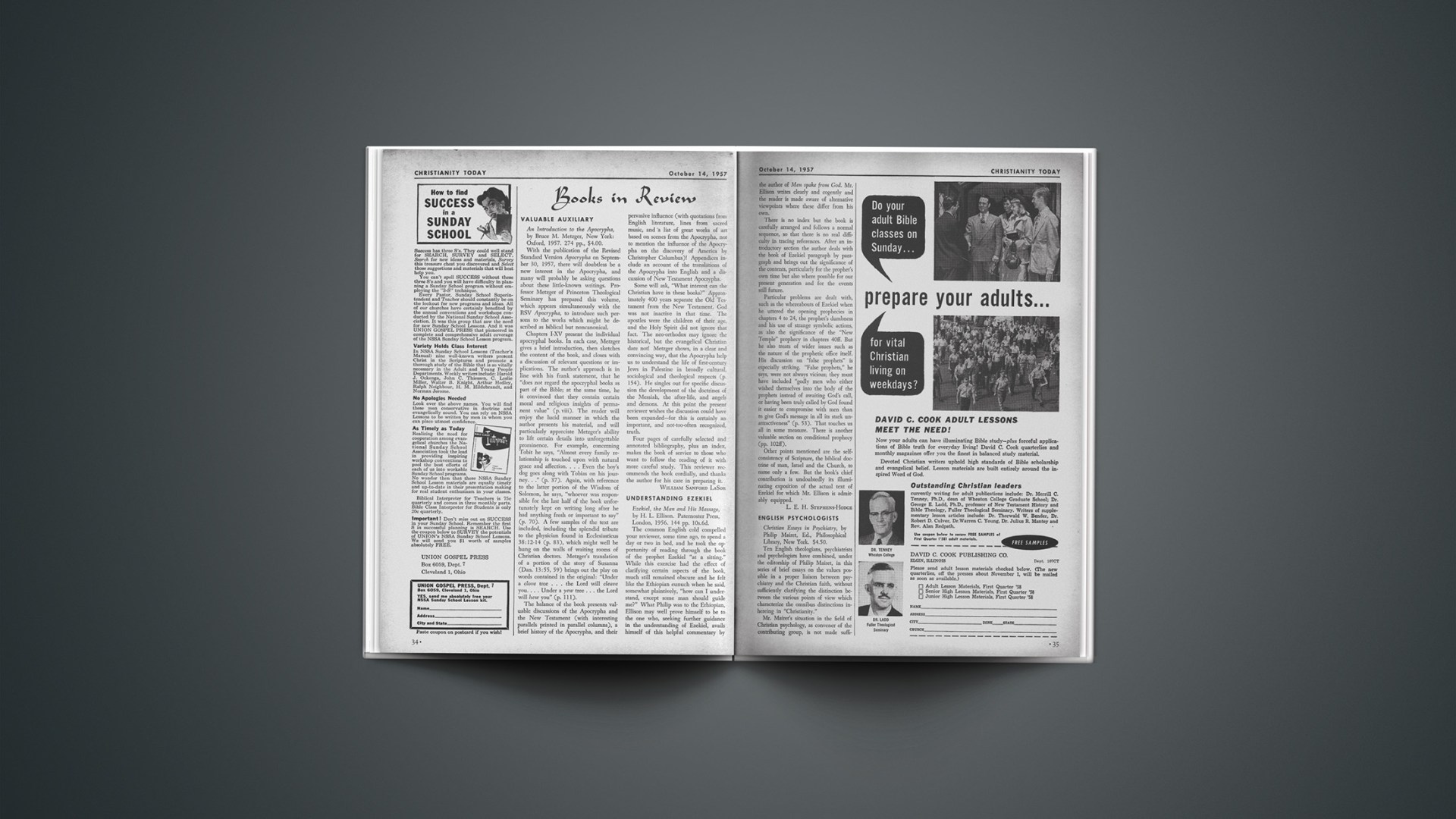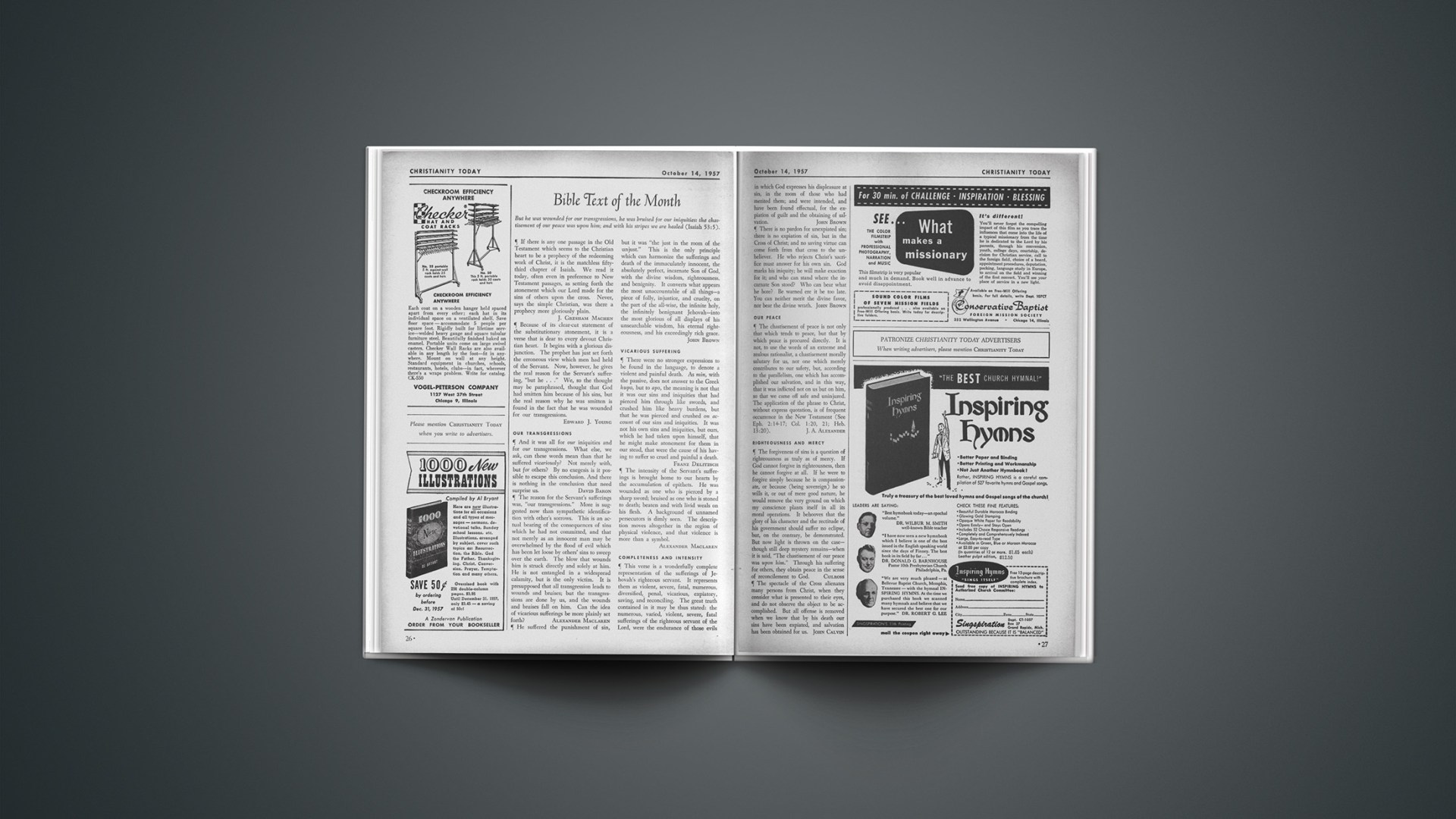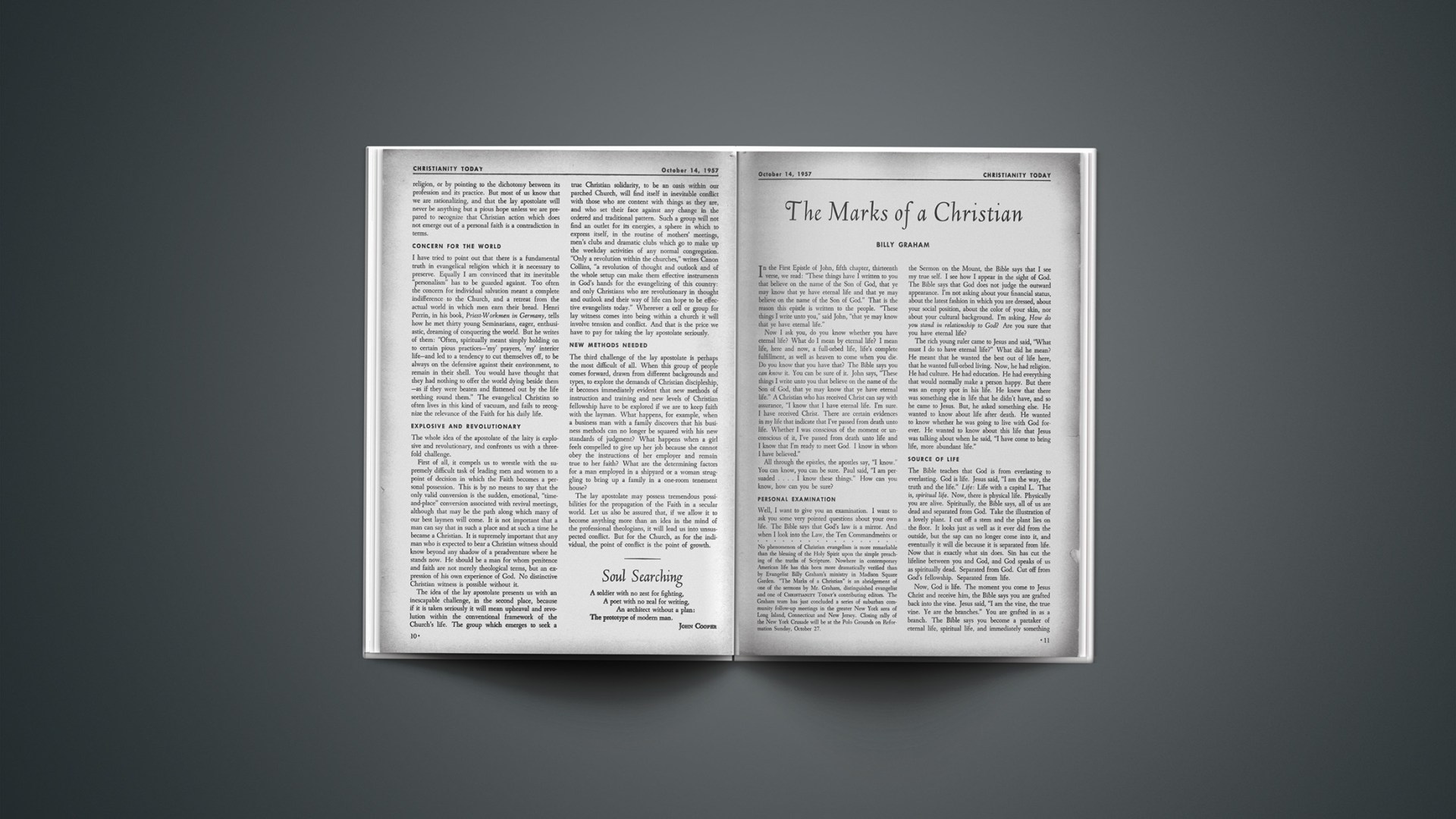Although reference has already been made in these columns to the report of the joint Church of Scotland and Church of England committee on “Relations between Anglican and Presbyterian Churches,” it might be well if one took a second look, particularly as it is now possible to gain a little indication of some of the reactions to the report. Moreover, a somewhat more detailed study of the report itself makes it possible to raise certain interesting, and probably important, points.
Perhaps the most striking thing about the report is that there is a tendency to take doctrinal agreement more or less for granted. In Appendix I there is reproduced the statement of agreement of doctrine upon which the Committee of Representatives had found themselves at one in 1934. This document, despite the changes in the committee’s personnel and the many changes in the theological climate of opinion since that day, apparently was regarded as being still acceptable to both groups. The real point at issue was that of the episcopacy. Or more concretely: how could episcopacy and presbytery be reconciled and amalgamated?
The report indicates that the committee feels that it has solved this problem which for the last three centuries has caused so much division and conflict between Episcopalians and Presbyterians. The suggestion is that the Presbyterians should have elected permanent bishops ordained by bishops of the Church of England and presiding over the presbyteries. At the same time the Episcopal churches should give the laity more place in the councils of their body, thus meeting the demands of the Presbyterians that the Church should be seen as a “communion of believers,” rather than an hierarchical organization. Although the present writer would hate to give the impression of being biased, he must confess that he feels that the Presbyterian representatives have surrendered most of their position.
In one sense, however, this is not the most important aspect of the report. It is, rather, those things which do not appear in the report that would seem to raise some of the biggest problems. For instance, there is the big question of the identity of the Church of England referred to in the report. Is it the Church of England of the Thirty-Nine Articles, or of Pusey, Keble and their Anglo-Catholic successors? When reference is made to the sacraments, are they the seven of Thomas Aquinas, or the two of the New Testament and the Protestant Reformation? The very fact that the Church of England representatives have insisted so strongly on the office of bishop being established in Presbyterian churches seems to indicate that it is the Puseyite tradition which is dominant in the negotiations.
It would seem, therefore, that although there is a basic statement of agreed doctrine, doctrine has not really been taken seriously in the preparation of this report. For instance the question of the differences between a fundamentally sacramental church and a Reformed church do not seem to have been adequately considered. This appears, for instance, when one finds that continual reference is made to the local clergyman of the Church of England as a “parish priest” (pp. 16, 17), while the Presbyterian teaching elder is called a “minister” (p. 15). This would seem to indicate that whether both churches have bishops and lay elders or not, the Presbyterians and Anglicans would still be in truth very far apart. In other words, the so-called unity and intercommunion which they would enjoy would be only a facade and not one of faith which would seem to be the only valid basis of outward and visible unity.
That this will be partly overcome by the conferring of Apostolic Succession on the Presbyterians through the ordination of bishops by the Anglican or Scottish Episcopal prelates would seem agreed. But the very admission that such an ordination is necessary raises for the Presbyterians many more questions than it settles. What about the ordination of all the other Presbyterian ministers? How about the validity of the Presbyterian sacraments, administered by non-episcopally ordained elders? What about much of the Church of Scotland’s law which is based upon the decisions of General Assemblies who specifically rejected the idea of episcopacy?
Most fundamental of all is the question of truth. From the statements of the report itself and also of some of its advocates, one receives the impression that unity is the most important aspect of the Church’s existence. Obedience to the teaching and example of the New Testament on this basis falls into a secondary place. Consequently, one finds in reading through this report that all arrangements for bringing about intercommunion give the impression of being compromises of principle for the sake of external unity. Whether it is right or not to have bishops or lay elders is not discussed on the basis of biblical authority, but on the ground of bringing about a uniformity which seems to be primarily a matter of expediency.
It is this attitude which is now apparently causing considerable misgivings in certain circles, particularly in Scotland. A number of ministers of the Church of Scotland have been pointing out that since bishops, according to the Presbyterian view, are not of the essence of the Church, they do not see that they are necessary for true intercommunion. They believe that such desirable relations may be brought about simply by stressing the unity of all those who truly trust in Christ as Saviour and Lord. True intercommunion is best able to grow out of this soil.
Many are also worried lest this report shall cause strife and conflict within the churches involved. Possibly it may. While this is to be regretted, history has shown that often out of such controversy has come forth a deepening and intensification of the Church’s self-consciousness, and a better understanding of its responsibility to Christ its Lord. It is, therefore, to be hoped that even out of such differences of opinion that Christ will bring forth in the Church a deeper understanding of the true meaning of Christian unity and a revived interest in the proclamation of his unsearchable riches.
• With this issue, Dr. W. Stanford Reid, Associate Professor of History, McGill University, Montreal, Canada, joins the list of regular contributors to “Current Religious Thought” for Volume II of CHRISTIANITY TODAY.—ED.
This review of live spiritual and moral issues debated in the secular and religious press of the day is prepared successively for CHRISTIANITY TODAY by four evangelical scholars: Professor W. Stanford Reid of Canada, Professor G. C. Berkouwer of the Netherlands, Professor John H. Gerstner of the United States and Dr. Philip E. Hughes of England.











